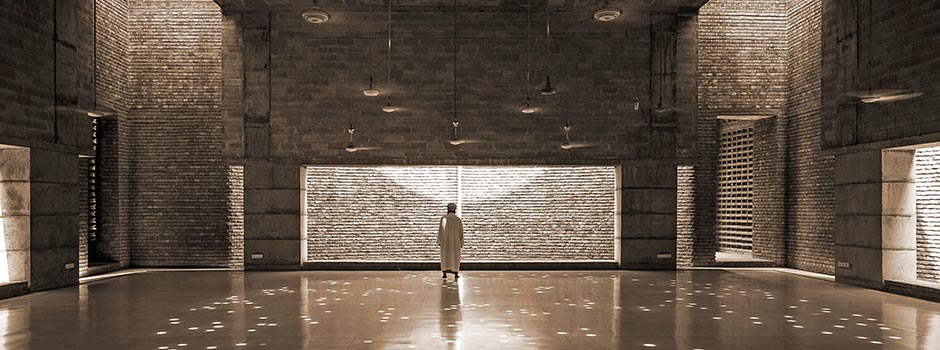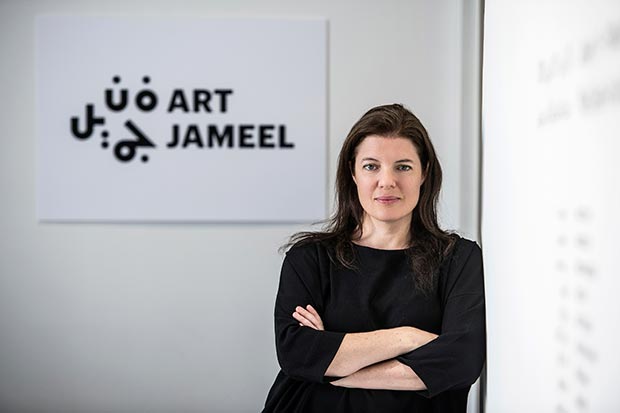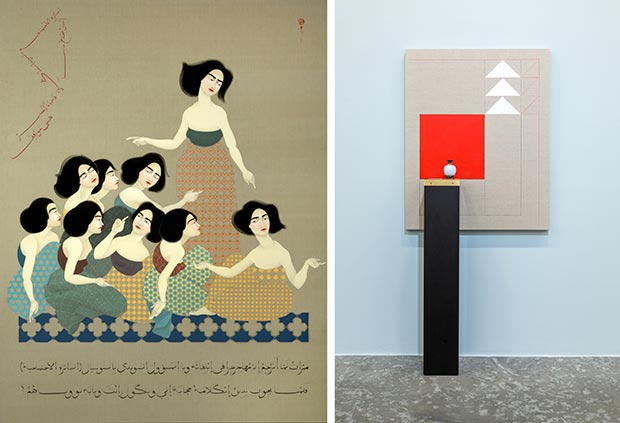
INTERVIEW WITH ANTONIA CARVER, DIRECTOR OF ART JAMEEL Islamic Design Has A Deep Contemporary Significance
Mar 19, 2018 Interview

Antonia Carver is Director of Art Jameel. Previously Director of Art Dubai (2010-2016), she led its development into the leading international fair for the Middle East and South Asia. Based in the UAE since 2001, Carver has written extensively on Middle Eastern art and film. In 2004, she joined Bidoun as an editor and later became the director of the organisation’s projects division. Carver has also served strategy and programming roles at the Dubai and Edinburgh international film festivals, the Institute of International Visual Arts, and Phaidon.
 Antonia Carver, Director of Art Jameel / Courtsy of Antonia Carver
Antonia Carver, Director of Art Jameel / Courtsy of Antonia Carver
My time at Art Dubai was a period of rapid growth for the organisation and likewise at Art Jameel, we’re in the process of building an organisation, its programmes and teams – but we have the added challenge of also building two new, major centres. As a team, we’re constantly asking ourselves how to ‘future-proof’ the centres, so the architecture and the programmes continue to attract audiences and grow appreciation for the arts over the generations to come.
 The Jameel Prize 5, shortlisted finalist: Hala Kaiksow, Shepherd’s Coat and Momohiki Jumpsuit, from the Wandress Collection (2015), Wool and denim / Photo © Sergio Miranda
The Jameel Prize 5, shortlisted finalist: Hala Kaiksow, Shepherd’s Coat and Momohiki Jumpsuit, from the Wandress Collection (2015), Wool and denim / Photo © Sergio Miranda
These are of course vast geographic regions, each with its own myriad traditions and challenges. Over the past 15 years, we’ve seen the international world sit up and take notice of the creative talent endemic to this part of the world, yet there is still so far to go in terms of creating opportunities for artists, filmmakers, writers and other creatives to develop their careers in the region, and to then engage international audiences in their work. Of course, there are huge social and political challenges, but the cultural field remains constant as a beacon of hope, especially for the large (often majority) youth sectors in society.
 The Jameel Prize 5, shortlisted finalists: naqsh collective, (nisreen and nermeenabudail), Shawl (2015), detail, Walnut wood, paint and brass / Courtesy of naqsh collective, Photo by Nabil Qutteineh
The Jameel Prize 5, shortlisted finalists: naqsh collective, (nisreen and nermeenabudail), Shawl (2015), detail, Walnut wood, paint and brass / Courtesy of naqsh collective, Photo by Nabil Qutteineh
The Jameel Prize is led by the V&A and its team, and we’re very proud to work with this encyclopaedic museum, with such fascinating, vast collections across design, fashion, architecture and art that go deep into the histories of the world. The Prize recognises that Islamic design has a deep contemporary significance; so many artists and designers, regardless of their medium, background and/or where they reside, are influenced by these traditions and design principles. For the shortlisted practitioners and then the winner, this Prize is not only significant in terms of recognition and the cash prize, but also in terms of exhibiting together with fellow artists from different disciplines—this year we have fashion and architecture alongside art and design—and building a narrative for the work around these shared principles of Islamic design.
 The Jameel Prize 5, shortlisted finalists: L. Wardha Shabbir, Two pillars (2017), Paper, opaque watercolour, Courtesy of the artist, Photo © Usman Javed / R. Mehdi Moutashar, Deuxcarrésdontunencadré, [Two squares, one of them framed] (2017), Wood, paint, elastic wire, Collection of the artist, Photo © Fabrice Leroux
The Jameel Prize 5, shortlisted finalists: L. Wardha Shabbir, Two pillars (2017), Paper, opaque watercolour, Courtesy of the artist, Photo © Usman Javed / R. Mehdi Moutashar, Deuxcarrésdontunencadré, [Two squares, one of them framed] (2017), Wood, paint, elastic wire, Collection of the artist, Photo © Fabrice Leroux
It’s hugely exciting to see such diversity of practice on the shortlist! We’re very much looking to the opening of the exhibition this summer at the V&A and to see where it then tours on to around the world. We’re also aiming to bring the exhibition to the Jameel Arts Centre in Dubai in 2019.
 The Jameel Prize 5, shortlisted finalist: Younes Rahmoun, Tâqiya-Nôr [Hat-light] (2016), Multimedia installation, here shown at the 57th International Art Exhibition – La Biennale di Venezia, Viva Arte Viva / Courtesy of the artist and Galerie Imane Farès
The Jameel Prize 5, shortlisted finalist: Younes Rahmoun, Tâqiya-Nôr [Hat-light] (2016), Multimedia installation, here shown at the 57th International Art Exhibition – La Biennale di Venezia, Viva Arte Viva / Courtesy of the artist and Galerie Imane Farès
With the Jameel Prize, we prefer to highlight the widespread influence of Islamic design principles, and the ways in which these traditions continue to inspire artists and designers from a wide range of backgrounds – rather than attempt to define "contemporary Islamic art" as such. Faith can be central to an artist’s practice, but their work is so often also influenced by their studies, their artistic heros and peers, their environment, experiences: this is what makes art and design so complex a field of expression and each practitioner unique to themselves.
 The Jameel Prize 5, shortlisted finalists: L. Hayv Kahraman, The Translator from the series How Iraqi Are You? (2015), Oils on linen, Courtesy of Defares Collection / R. Kamrooz Aram, Ephesian Fog (2016), Multimedia installation, Courtesy of the artist and Green Art Gallery, Dubai
The Jameel Prize 5, shortlisted finalists: L. Hayv Kahraman, The Translator from the series How Iraqi Are You? (2015), Oils on linen, Courtesy of Defares Collection / R. Kamrooz Aram, Ephesian Fog (2016), Multimedia installation, Courtesy of the artist and Green Art Gallery, Dubai
If we look at this year’s shortlist, or the Jameel Prize 4 exhibition, we see that so many of the artists and designers represented are exploring a range of themes and subjects – indeed, it’s their interest in Islamic tradition that opens the door for them to express such intricate ideas. Moreover, it’s as tricky to define ‘Western taste’ as it is to define ‘Eastern’ or ‘Islamic’, and within the Euro-American artworld, there are certainly many that eschew sensationalist art that attempts to court controversy for notoriety’s sake.
 The Jameel Prize 5, shortlisted finalist: Marina Tabassum, Prayer Hall, Bait urRouf Mosque, Dhaka, Bangladesh (2012) / Photo by Sandro di Carlo Darsa, © MTA/Sandro di Carlo Darsa
The Jameel Prize 5, shortlisted finalist: Marina Tabassum, Prayer Hall, Bait urRouf Mosque, Dhaka, Bangladesh (2012) / Photo by Sandro di Carlo Darsa, © MTA/Sandro di Carlo Darsa
We’re in a particularly exciting period of growth as an organisation: later this year, we open the Jameel Arts Centre, Dubai, and then in 2019, our centre in Jeddah, Hayy: Creative Hub, is set to open its doors as a community-oriented home for the creative field as a whole. Meanwhile, our work in heritage just grows and grows – the Jameel Houses of Traditional Arts in Cairo and Jeddah are not only offering diploma and teaching programmes, but also opening up for evening and weekend classes, and adding public talks into the mix, plus participating in local festivals.
Thank you so much for your ongoing interest in our work; we’re delighted to have the opportunity to engage with your readers, with whom we have so many interests in common.
Comments
Add a comment